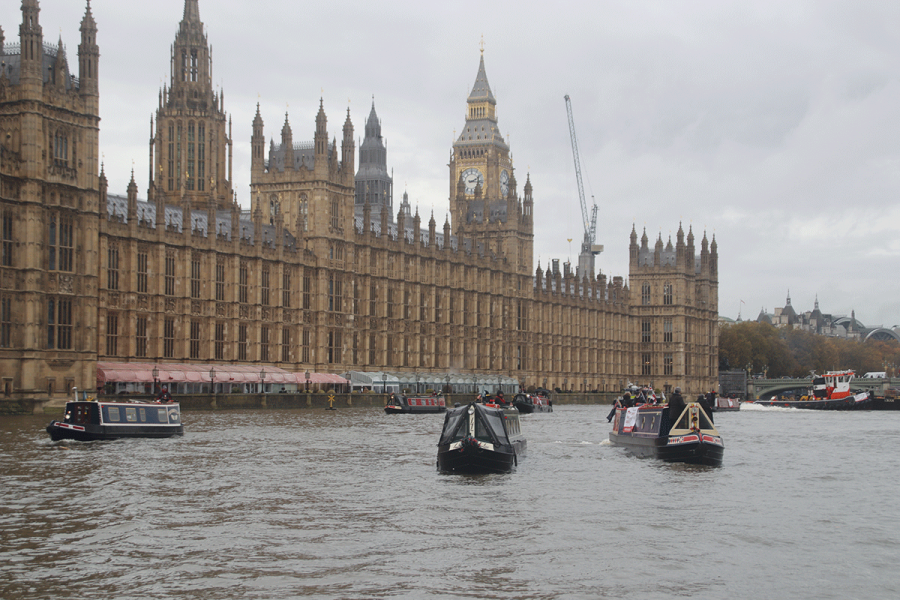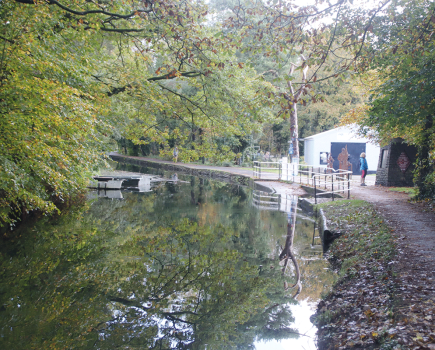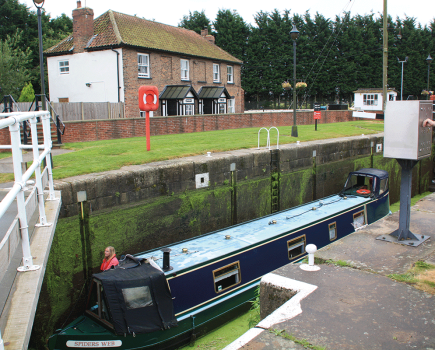On a gloomy November day, campaigners against cuts in public funding for the waterways took their fight to the Houses of Parliament by water. Martin Ludgate was on board…
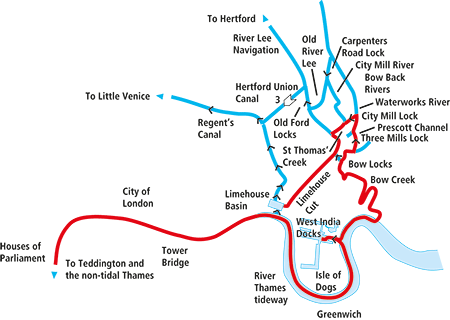
The red line shows the convoy’s route from Limehouse via City Mill Lock, Prescott Lock, Bow Creek and the West India Docks to the Houses of Parliament
At a first glance it could be mistaken for the start of one of St Pancras Cruising Club’s regular Thames tideway trips: a long line of narrowboats moored in East London’s West India Docks, crew members in lifejackets, and cruise leader Andrew Phasey calling all skippers in for a pre-cruise briefing (indoors, in a basement toilet / shower block rather than on the dockside, as the rain’s getting a bit heavy!) But this time it’s something rather more serious than an adventurous trip through central London. We’re about to head off on a campaign cruise to the Houses of Parliament to publicly raise the urgent matter of ensuring there’s enough money to keep the waterways network maintained – hence why it can’t wait until there’s a likelihood of more favourable weather in the springtime.
This is the third of a series of major campaign cruise events organised around the country under the banner (quite literally, the boats are all carrying them!) of Fund Britain’s Waterways. FBW is a campaign group combining over 100 boating-related bodies, assembled to put the case for a more generous settlement for the Canal & River Trust than the one announced in summer 2023 which would see public support reduced so steeply in real terms that CRT’s Chief Executive Richard Parry has voiced his fears that we could see indefinite canal closures within a decade – and to campaign more widely for adequate funding for all waterways, not just CRT’s.
Most of the boats may be St Pancras Cruising Club regulars, but they’ve provided space on board for those who don’t have boats that they can get to this part of the network – and some have travelled down from the north of England to take part. I’ve been kindly offered a place on narrowboat Galatea by longstanding SPCC boater Ollie, who’s also hosting national representatives of the Association of Waterways Cruising Clubs, one of a number of major organisations that make up the FBW steering group.
But before we head out onto the tideway, let’s just rewind a couple of days to the preparations for the trip, and the reason why the boats were setting off from the perhaps slightly unexpected location of the Isle of Dogs.
The shortest route from non-tidal water to the Houses of Parliament would be via Limehouse Basin entrance lock, where the Regent’s Canal meets the river. But the limited capacity of the lock, coupled with the aim of arriving at Westminster around high tide, would mean that several lockfuls of boats would need to form up into a convoy in the fast-flowing tidal water. By contrast, the ship-sized lock at the West India Docks can easily take the whole convoy in one locking.
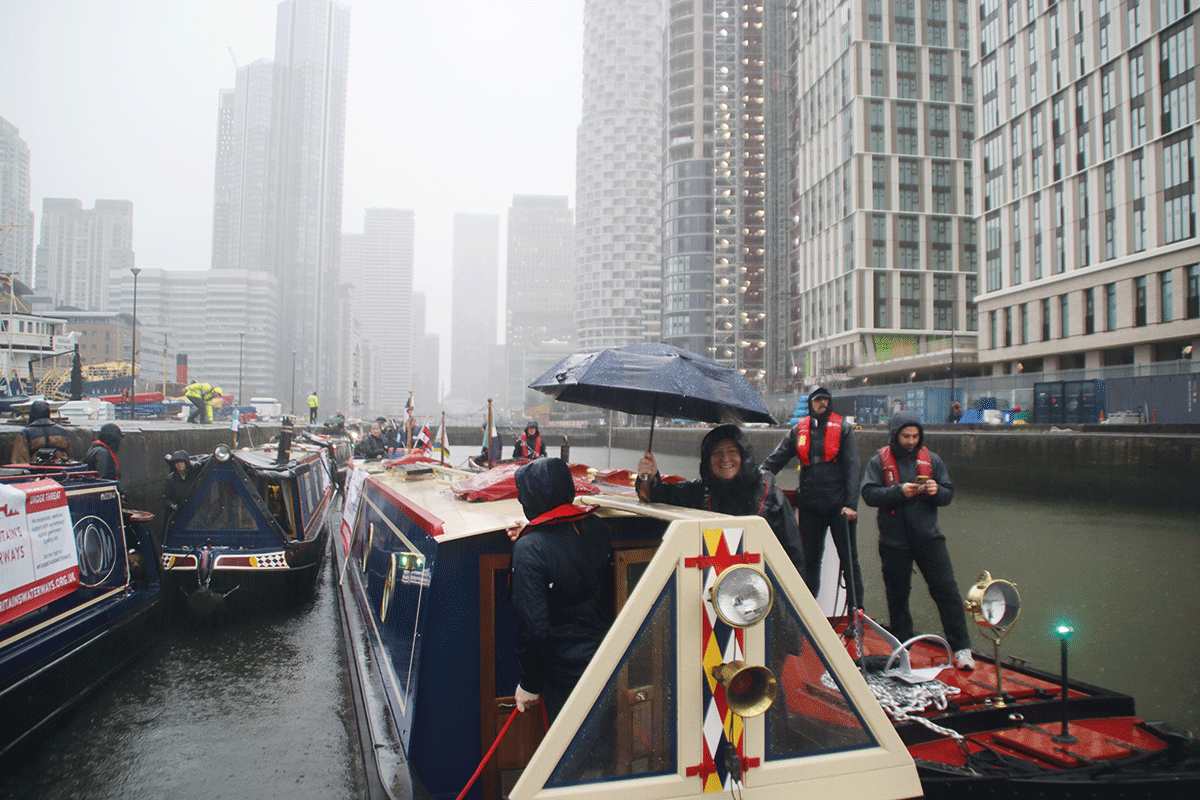
The weather got heavier as the boats set out for Westminster
However, the West India Docks aren’t directly connected to the canal system, so an initial tidal passage was planned the day before the campaign cruise, to get the boats from the Regent’s Canal to West India Docks. And this too didn’t use Limehouse Lock, it took an unusual route through the Bow Back Rivers network, from the lower Lee at Bow Bridge via the restored City Mill Lock and the modern Three Mills Lock (newly built to take waterborne construction traffic to the 2012 London Olympics, traffic which sadly never materialised) to Bow Creek and the Thames. Again, there was method in this apparent madness: Three Mills Lock is big enough to take the whole convoy.
And this was preceded a day earlier by an evening crew briefing kindly hosted by the Cruising Association in their base by Limehouse Basin, once all the boats had gathered.
So by the time I arrive in the rain at the West India Docks, the crews have already been fully briefed on taking narrowboat onto the tidal Thames, and Andrew is running through some final points. We are to use our navigation lights in the poor weather; we are to observe the 70 metre exclusion zone around the Palace of Westminster (although as Andrew says, “No-one’s going to be there with a tape measure!”); and we are to make a loud noise with our horns to make sure the MPs can hear us.
The steady rain is turning to a downpour as we cast off and head into the entrance lock. Our ten craft (sadly the hoped-for numbers have been depleted by several owners taken ill or with problems; not to mention the logistics of getting there during the CRT and Thames winter work programme) are completely dwarfed by the vast chamber, but helpful CRT volunteers drop ship-sized ropes to us from the lockside and we’re soon through, and with a long blast on our horns we’re entering the tideway.
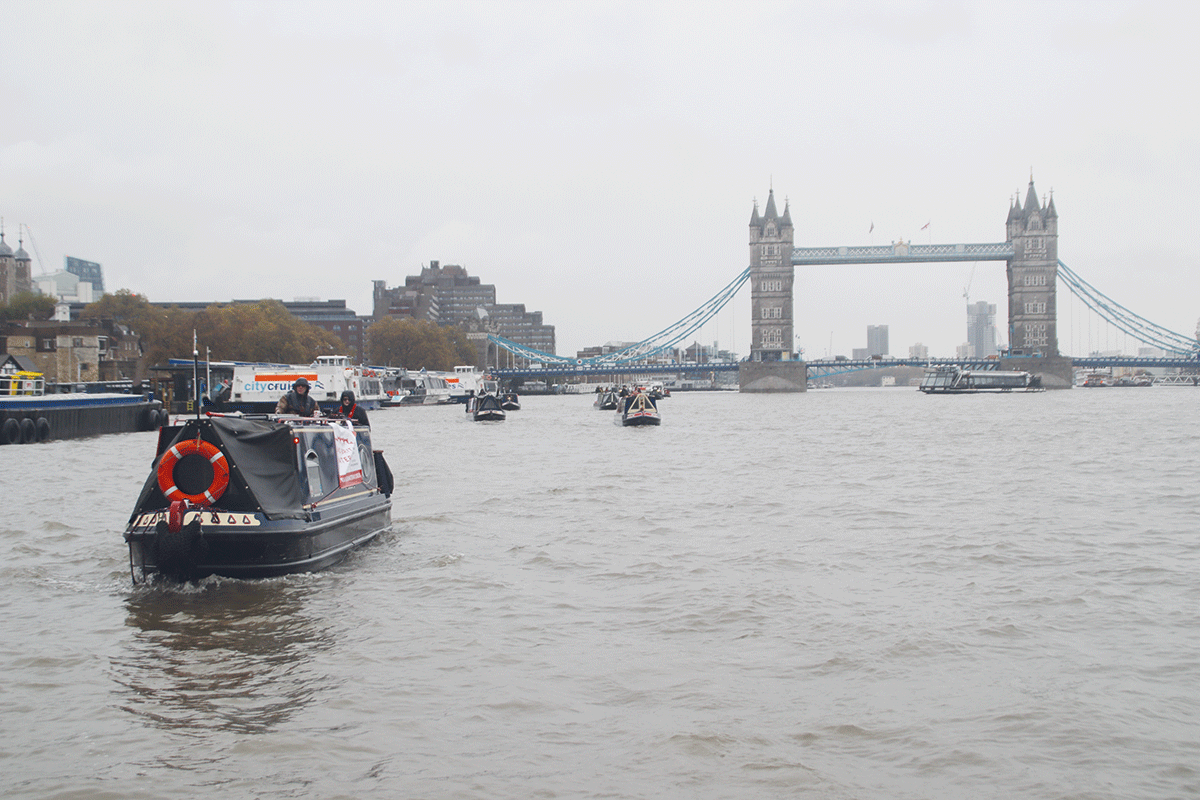
Passing under Tower Bridge with just a couple of miles to go
The familiar sights of the Cutty Sark at Greenwich, the skyscrapers of the Isle of Dogs and the City, and a glimpse of Limehouse Basin entrance lock as the tide sweeps us past, lead to the approach to the city and a view of Tower Bridge ahead. It certainly won’t need to open for us; in fact, we follow the advice to small craft to use the non-opening northern side-span, leaving the central opening span clear for the assorted trip-boats, ‘Clipper’ fast catamaran waterbuses, and tugs pulling sets of lighters carrying the capital’s rubbish downriver (we pass four of these in total – the Thames is still a working river, even if its main cargo is a less-than-glamorous one).
The bridges come thick and fast as we pass through the heart of the capital: London Bridge, Southwark Bridge, the Millennium Bridge, Blackfriars Bridge and Waterloo Bridge, plus a couple of railway bridges. We’re soon approaching Westminster, just a couple of minutes ahead of our schedule of an easily-remembered 14.11hrs on the 14th day of the 11th month (which just happens to be the predicted time of high water). Passing under Westminster Bridge we get a cheer from the assembled waterways supporters lining the pavements and waving ‘Fund Britain’s Waterways’ banners, and then we’re at our destination.
Our fleet of narrowboats is enlarged by the arrival of two commercial craft – a river fuel barge and a tug pushing a lighter loaded with piling and other construction materials – which are also decorated with Fund Britain’s Waterways banners, and help to make the point that waterways funding isn’t just an issue for leisure and residential boaters. They also make quite an impact in another way, as their horns are quite a few decibels louder than the rest of the convoy when everyone gives it several minute of blasting away to wake up the MPs and Lords and let them know there are some boats and some concerned boaters outside the Palace of Westminster.
And then it’s time to return downriver, as the tide starts ebbing away. The rain has ceased, although one wouldn’t exactly say it was pleasant weather when we were making our point, but as we head back through Tower Bridge (this time using the central lifting span, as the southern side-span is less suitable) the weather clears and the sun finally appears for our trip round the Isle of Dogs. We’re passed by a loaded aggregates barge heading (we think) for a wharf on Deptford Creek as well as more rubbish lighters and waterbuses, but the river’s clear as we reach the point where we have to turn left and cross the river to get to the West India Docks entrance lock, where we’re all locked through and moored up just as the daylight fades.
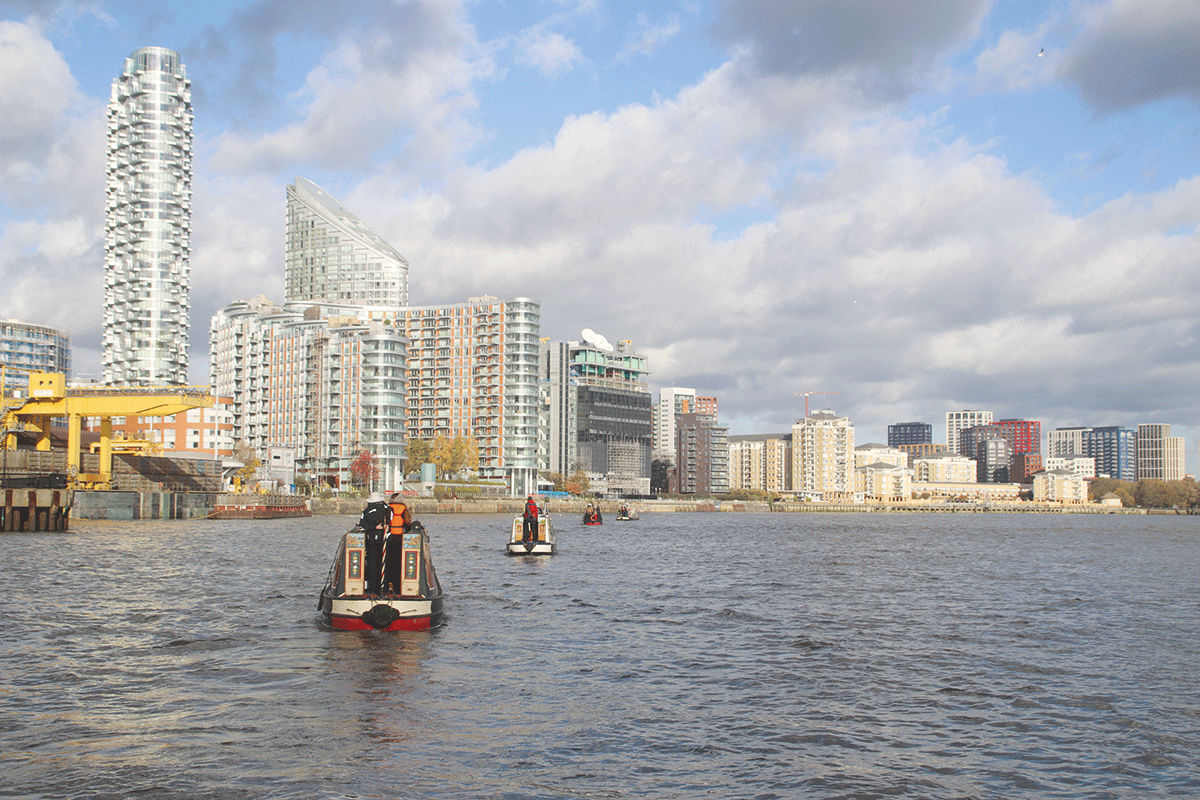
Better weather for the return trip from the West India Docks the following day
That isn’t quite the end, though. The boat moor overnight in the docks, but there’s still the return journey back to the canals the following day. Once again we’re using the route via Bow Creek, Three Mills Lock and City Mill Lock, but there are enough extra complications for Andrew to call a final crew briefing before departure.
Firstly, rather than having to cross to the right-hand side of the river, only to have to cross back again just a few minutes later to get to Bow Creek, we’ve arranged a dispensation with the Port of London Authority to go ‘wrong side’ and hug the north bank for this short distance. And secondly, we’re expecting to have to wait some time for Three Mills Lock to be operated.
Sure enough, after following the north bank, taking the left turn, and heading up Bow Creek past Bow Locks to Three Mill Lock, we’re informed by ‘our’ lock keeper (SPCC now have several members who are approved by CRT as volunteer lock keepers, saving staff having to come out to work these seldom-used powered locks) that we may have 90 minutes’ delay. This is down to the rather complicated nature of the adjacent tidal sluice…
The sluice rises automatically to keep the high tide out when the level of the tide is higher than the water on the non-tidal side. Then once the tide has fallen to a level that’s lower than the water on the non-tidal side, it lowers automatically to allow water coming down the River Lee to escape down the creek and into the Thames. But after heavy rain, there can be sufficient water coming down the Lee that during the couple of hours around high water while the sluice is raised the water ‘backs up’ in the channels north of the lock to the point where there’s insufficient headroom for boats under the bridge carrying Stratford High Street. At this point, a safety feature kicks in and the lock refuses to operate until the water has fallen to a safe level. And that’s what has happened.
We have ample time to watch the functioning of this interesting setup before the weir finally lowers right down, allowing a rapid flow of water, and the level soon drops enough for the lock to operate. There’s still quite a current as we leave the lock, slowing our progress and making the tight turn into City Mill Lock a little awkward, and it’s almost dark as we return to the Lee Navigation, and the boats disperse towards their home moorings.
So did we have an impact on the Government? It would be unrealistic to claim that a dozen boats would change the collective mind of any bunch of politicians, however convincing their arguments. But perhaps, as part of a series of similar events (they have already taken place in Birmingham and Gloucester and more are planned for 2024 – see our news pages), backed up by other types of campaigning, and sustained through the forthcoming General Election and beyond, there might just be some hope of getting the message across.
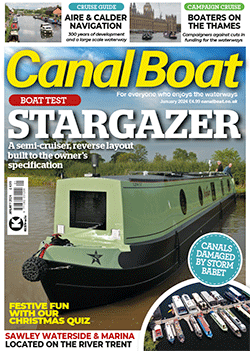 As featured in the January 2024 issue of Canal Boat. Buy the issue here
As featured in the January 2024 issue of Canal Boat. Buy the issue here

